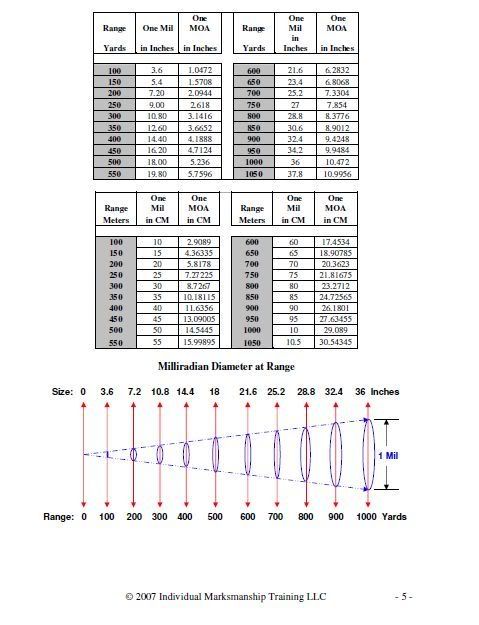You are using an out of date browser. It may not display this or other websites correctly.
You should upgrade or use an alternative browser.
You should upgrade or use an alternative browser.
Mil dot value
- Thread starter Ervin
- Start date
Yes. You said 10x, but that may or may not be accurate for your scope. Each variable, second focal plane reticle scope has a magnification at which it subtends correctly. Your literature or manufacturer can tell you for sure.If a mil is worth 3.6in at 100 yards, whats it gonna be at 200? 7.2in? and 10.8in at 300?
3.6" at 100 yards and 36" at 1000 yards, that makes figuring that part of the equation simple once you get used to thinking in mils and not moa's. Scope isn't going to change that no matter what power you put it on, a miliradian is a miliradian is a miliradian.
A good $40 would be this book/calculator
http://www.brownells.com/.aspx/sid=...838393130303030302d3838393130303030302d343037
A good $40 would be this book/calculator
http://www.brownells.com/.aspx/sid=...838393130303030302d3838393130303030302d343037
The Mil-Dot
The "Mil" in "Mil-Dot" does not stand for "Military"; it stands for "milliradian." The radian is a unitless measure which is equivalent, in use, to degrees. It tells you how far around a circle you have gone. 2 PI radians = 360 degrees. Using 3.14 as the value of PI, 6.28 radians take you all the way around a circle. Using a cartesian coordinate system, you can use "x"- and "y"-values to define any point on the plane. Radians are used in a coordinate system called "polar coordinates." A point on the plane is defined, in the polar coordinate system, using the radian and the radius. The radian defines the amount of rotation and the radius gives the distance from the origin (in a negative or positive direction).
ANYWAY, the radian is another measurement of rotation (the degree/minute/second-system being the first). This is the system used in the mil-dot reticle. We use the same equation that we used before, but, instead of your calculator being in "degree" mode, switch it to "radian" mode. One milliradian = 1/1000 (.001) radians. So, type .001 into your calculator and hit the "tangent" button. Then multiply this by "distance to the target." Finally, multiply this by 36 to get inches subtended at the given distance. With the calculator in "radian" mode, type:
tangent(.001)*100*36 = 3.6000012"
So, one milliradian is just over 3.6 inches at 100 yards. If we extrapolate, two milliradians equal about 6 feet at one-thousand yards. You'll see the importance of this, shortly.
The Mil-Dot Reticle
The mil-dot reticle was designed around the measurement unit of the milliradian. The dots, themselves, were designed with this in mind and the spacing of the dots was also based upon the milliradian. This allows the shooter to calculate the distance to an object of known height or width. Height of the target in yards divided by the height of the target in milliradians multiplied by 1000 equals the distance to the target in yards. For example, take a 6-foot-tall man (2 yards). Let's say that the top of his head lines up with one dot and his feet line up four dots down. So: (2/4)*1000 = 500 yards away. This same tecnique can be used to estimate lead on a moving target or to compensate for deflection on a windy day.
The distance from the center of one dot to the center of the next dot is 1 milliradian. We are told (by the folks at Leupold) that the length of a dot is 1/4 milliradian or 3/4 MOA (Given this much information, one can determine that the distance between dots is 3/4 milliradian.).* I use the term "length" because the mil-dot is not round. It is oblong. The "dots" on the verticle crosshair run oblong in the vertical direction. The dots on the horizontal crosshair run oblong in the horizontal direction (i.e., they are lying on their sides). The width of each dot is an arbitrary distance and is not used for any practical purpose. Like a duplex reticle, the mil-dot reticle is thicker towards the edges and uses thin lines in the middle where the dots are located and the crosshairs cross. The distance between the opposite thick portions is 10 milliradians.
*NOTE: 1/4 milliradian = .9" and 3/4 MOA = .785", so, obviously, a mil-dot cannot be both 1/4 milliradian and 3/4 MOA. I called Premier Reticles (they make Leupold's mil-dot reticles) and got an explanation: the dots on their mil-dot reticles are 1/4 mil. They are not 3/4 MOA. Apparently, they (Leupold?) just figured that more shooters understand MOA than milliradians, so they just gave a figure (in MOA) that was close, but not super precise. You can contact Premier Reticles via e-mail and request literature or ask questions.
Summary
To use a mil-dot reticle effectively, all one need remember is that the distance between dot centers is 36" at 1000 yards. This lets you determine the range of a target of known size. At that point, you can dial the scope in for proper elevation OR use the dots to hold over the proper amount. The dots on the horizontal crosshair can be used to lead a target (if you know the range to the target, then you'll know the distance between dots, and thus the distance to lead) or to compensate for deflection.
All you ever wanted to know about mil-dots and minutes-of-angle, and then some!
http://www.snipercountry.com/articles/mildot_moa.asp
The mil marks on your second focal plane reticle are not always a mil. The power matters tremendously if you want to use the reticle for distance estimation or hold-over.Scope isn't going to change that no matter what power you put it on, a miliradian is a miliradian is a miliradian.
http://www.shootingtimes.com/optics/poptics_101107/index.html
Last edited:

